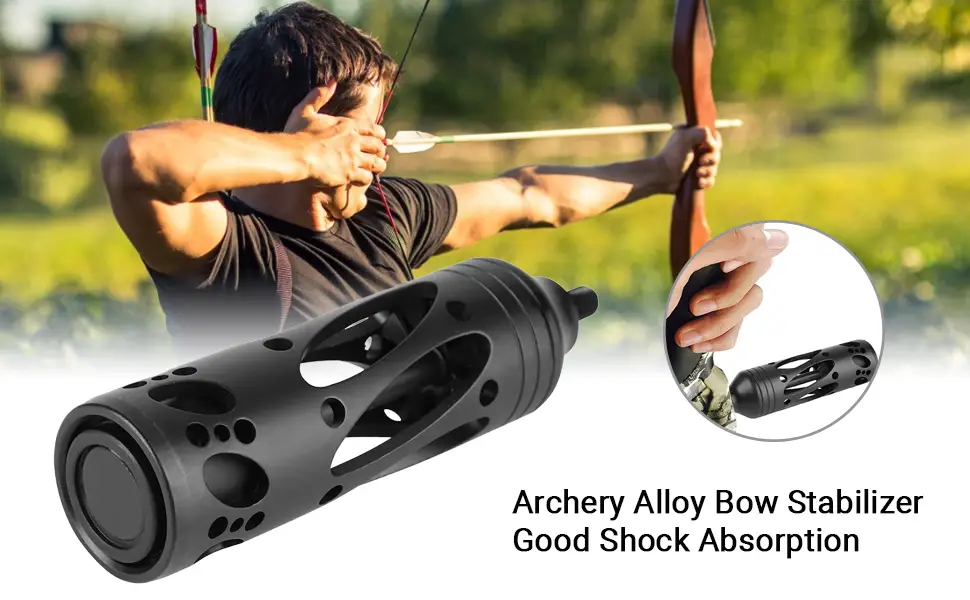How does a bow stabilizer work? Guide: 2024 Updated
Bow archers these days wonder why they can’t aim for the target? And why do their bows make noise?
In addition, the archer experiences excessive vibrations in its bow after its launching, and this is where the need for a bow stabilizer arises. The bow stabilizer is the revolution in hunting as it increases accuracy and provides better stability to perfect your skill.
Below is the complete ultimate guide article on how does a bow stabilizer work?
How to balance a bow with stabilizers?
Stabilizers minimize the vibration whenever the archer releases the arrow and then balances the bow by elevating its inertia.
However, the bows can quickly feel imbalanced and unstable without utilizing the stabilizers while the archers aim. They potentially make it hard to clasp the required bow stationary. They can also feel the extensive bow vibrations after the arrow is launched.
Bow Vibration
Many modernized hunting and target bows effectively shoot arrows with significant force. The acceleration of an arrow is hundreds of times more than gravity, which is 9.8 m/s2. With a lot of pressure advancing the arrow and the bow not being the right mechanical system, it doesn’t transfer all of its energy stored that is 100%. The wasted energy is being discharged in the form of vibrations and sounds.
The pulse of the bow is considered to be a frequency that is highly forced. It can easily hurt the archer. In extreme scenarios, vibrations repeatedly occurring via the elbow and wrist can initiate tennis elbow, carpal tunnel, and tendinitis. The repetitive motions from archery and powerful vibrations from bow showing may enhance the odds of undergoing any physical problems.
Quality Stabilizers
It is the quality of the best bow stabilizers to consume the shock and enhance the shooting careers of archers potentially. With the stabilizers poking out from the bow and various shock adaptable absorbers such as Doinker A-Bombs being associated with the bow, the vibrations are supposed to deplete relatively faster.
This mechanism results in more delightful shooting, and there is much less chance of pain and stress within the bow arm of an archer.
Effect On Aiming
Inertia is the tendency of an object to either keep moving or stay at rest
By introducing a ‘stabilizer for the bow’, you may quickly smooth the process of aiming by elevating the overall inertia of the bow, which can correspond to minimizing motion.
Increasing bow mass increases accuracy
In such a scenario, elevating the mass of the bow can quickly slow down the movement within the arm of the archer’s bow while they begin aiming. It also enhances the ability of the archer to focus steadily on the center of the target.
Mass increase doesn’t work all the time
However, it is quite possible to include quite a mass weight to the bow, which results in poor outcomes and rapid fatigue. It would help if you kept in mind that increased mass does not assure more outstanding scores.
Find your ideal bow mass
The archers can quickly examine the weight distribution to determine whether the setup is more neutral or front-heavy. Conveniently, you can indulge in what various other archers are doing with their required arrangements of stabilizers. To copy the configuration of the stabilizers of the best archers is quite common.
However, it is advised that archers should experiment with various setups to find out what bow counterweight suits them best. Each archer is quite distinguished, and therefore the configurations of stabilizers can vary depending on the dynamic or static shot.
The weights of the stabilizers can be customizable, which provides you with unending opportunities to discover your options. You can experiment with as many combinations as you like but keep in mind that you must shoot stabilizer, not execution because it makes the arrow hit the center point.
Setup for Stabilizer
Many people ask which is the ideal weight and length for a combo stabilizer back bar. There is no simple answer to this question as it relies on the preference of the shooter and various physical aspects of the bow. All you require is to fiddle with the counterweight and back bar spot. You can also dabble with the bow counterweight and length of the front stabilizer till you find the right one.
Steps In The Process
There is also a fundamental process that you can follow:
- Firstly, you are required to check the position of the bow. Is it horizontal? It is ideal for evoking the arrow with the left-handed bow to ensure a perfectly balanced setup. You may settle them into an anchor by closing your eyes and then opening them.
- After this, you must look at the sight bubble to determine if it is on one side or in the middle? It is recommended that the sight level should be leveled perfectly. If it’s not balanced, you put a counterweight on one side of the bow to even up any weird cant in hopes while the bow is centering itself. To perform this sort of test at full draw is quite challenging because the shooting form can exert a minimal amount of torque, allowing the bow to balance it differently.
- The next step is to keep on shooting the bow for various days while you take notes and observe the movement pattern of the sight pin. If you follow that the sight pattern is consistently dipping down, you can minimize the stabilizer weight or introduce back bar weight.
- To become a better hunting archer, you need to analyze the minute details. For example, outfitting your bow with the right sort of stabilizer can improve.
How does a bow stabilizer work? FAQs
How does a bow stabilizer work?
The stabilizer minimizes the vibration level when the archer releases the arrow and stabilizes the bow by enhancing inertia. Without these, the bow can feel imbalanced whenever archers aim, making it difficult to hold their bow stationary.
Where Can We Find a Stabilizer Located On A Compound Bow?
These are usually installed within the tapped hole beneath the grip and onto the front of the bow.
What Do We Know About The Archery Stabilizer Weight Formula?
By taking the length of the front rod (LFR) and multiplying it with the added weight on the front rod (WFR), you can divide the outcome (XFR) with the length of the side rod (LSR) to gain the weight (WSR) to be added to the side rod. If you utilize two side rods, you can divide the added side rod weight (WSR) by 2 (WSR/2).
Which Size Stabilizer Is Ideal For A Hunting Bow?
A 10 to the 12-inch bar for Western bow hunting is usually favorable and considered the best bow stabilizer.





